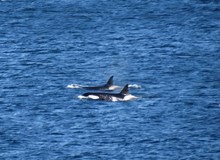03 June, 2015
Whale of a sighting at the Isle of May
The Isle of May has hosted some spectacular wildlife in its time, but nothing as impressive as a recent sighting when the island residents discovered six killer whales.
The animals, including one bull, four females and a youngster, were spotted on 28 May. They moved slowly along the east side of the island before checking out the grey seal colony on the north tip of the island. After one hour of viewing, the pod eventually headed off out into deeper water and north towards the Fife coastline.
The spectacular sight was witnessed by all staff and researchers on the island and represents only the third modern day record of these marauding giants. David Steel, Scottish Natural Heritage (SNH) Isle of May reserve manager said, “To see killer whales in the UK is a very special experience, but to see them in the Firth of Forth is even more special.”
David added, “The shout went up across the island from the team and, as you could imagine, pandemonium let loose as people were running for binoculars, shoes and running off in all directions.”
Following the chaotic scenes, everyone assembled on the east side of the island to watch the pod move north allowing great views of these rare visitors.
The killer whales were followed by the first Minke whale sighting on 30 May, along with a scattering of harbour porpoise sightings. And with the onset of summer, there will likely be more cetacean sightings from the island.
The Isle of May is open to visitors from 1 April - 31 September. It’s free to visit the nature reserve, but you must take a boat trip to reach the island. Sailings are on the privately-run May Princess or Osprey of Anstruther from the Anstruther Harbour or through the Scottish Seabird Centre in North Berwick.
Anstruther - for tickets and details, see www.isleofmayferry.com (May Princess) or www.isleofmayboattrips.co.uk (RIB Osprey).
North Berwick - for tickets and details, book online on the Scottish Seabird Centre website at www.seabird.org or call 01620 890202.
Known locally as 'The May', this small island sits on the edge of the Firth of Forth. The island's importance for seabirds has drawn scientists to its shores for many years and the May is home to the oldest continuously running bird observatory in the UK. The May is also a regular haunt for grey seals, often seen lounging on the shoreline rocks. This island is a historical gem and it's been a place of pilgrimage for centuries with an early island monastery. The May was also the site of Scotland's very first lighthouse, built in 1636, while the current, castle-like lighthouse was designed by the engineer Robert Stevenson.
The island is one of more than 50 national nature reserves in Scotland. These are special places that look after some of the best of Scotland’s nature on behalf of everyone who lives or visits Scotland, and they provide unique opportunities to visit, enjoy and learn more about Scotland’s nature. For more information, see www.nnr-scotland.org.uk
Contact information
- Name
- SNH Media
- snhmedia@snh.gov.uk
NatureScot is Scotland's nature agency. We work to enhance our natural environment in Scotland and inspire everyone to care more about it. Our priority is a nature-rich future for Scotland and an effective response to the climate emergency. For more information, visit our website at www.nature.scot or follow us on X at https://x.com/NatureScot
’S e NatureScot buidheann nàdair na h-Alba. Bidh sinn a’ neartachadh àrainneachd na h-Alba agus a’ brosnachadh dhaoine gu barrachd suim a chur ann an nàdar. Tha e mar phrìomhachas againn gum bi nàdar na h-Alba beairteach agus gun dèilig sinn gu h-èifeachdach le èiginn na gnàth-shìde. Tha an tuilleadh fiosrachaidh aig www.nature.scot no air X aig https://x.com/NatureScot

